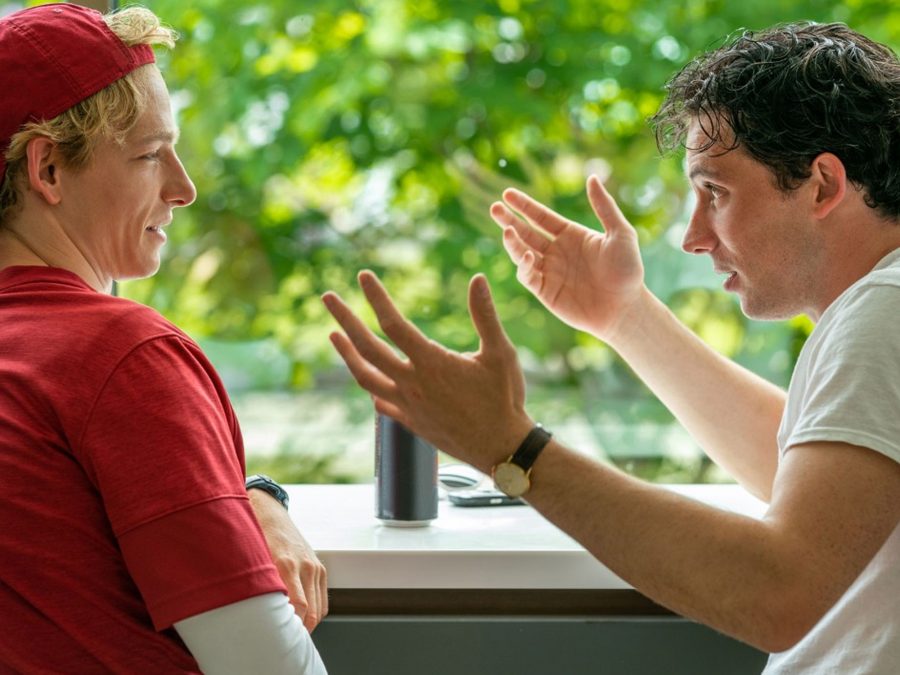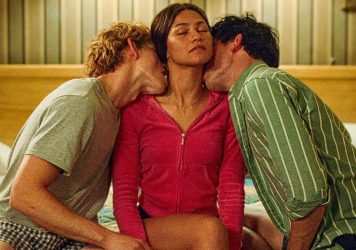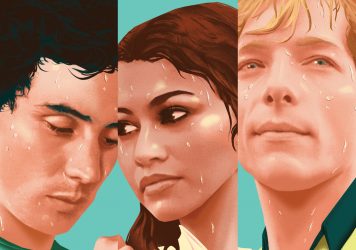
We catch up with the Italian provocateur behind Challengers: the sports drama starring Zendaya, Josh O'Connor and Mike Faist, that's getting pulses raising around the world this spring.
It’s 6.59am Pacific Standard Time, and Luca Guadagnino is sat in the passenger seat of a packed car, shades balanced on dome, and looking down into his smartphone to begin our chat. The last time I spoke to the director was on the occasion of Call Me by Your Name’s swift ascent to the deserving status of global sensation, and in the spirit of the film we conversed while Guadagnino did his morning walk around his one-time hometown of Crema, pausing occasionally to greet passers by.
The subject now is Challengers, a skillfully-wrought romantic melodrama of the old school that’s set in the world of professional tennis, where the tense ebb and flow of a men’s singles match between Josh O’Connor’s Patrick and Mike Faist’s Art is compounded further by the slow release of details about both of their relationships with Zendaya’s injured almost-star, Tashi. It’s a film of visual razzmatazz and cheeky humour that’s powered by a trio of stunningly attuned central performances and the kind of character chemistry that’s definitely not available over the counter.
LWLies: How did you first encounter the script for Challengers and what were your first impressions?
Guadagnino: I think at this stage of my life, after having done so much and for so long, it should be clear that I am a director who likes to find projects instead of writing my own projects. And I feel that in order to clarify what the director does, the director directs a movie and finds his, her, their point of view within the bones of a story or a script. Someone would say this is the old fashioned way of doing classic cinema. In that sense, how I found the story is quite simple: I was sent a script by a person that I trust very much, [producer] Amy Pascal. What I found in the script is a very witty, entertaining and dynamic story that had this great concept of tennis and relationships bouncing within one another and one being a mirror to the other. To me it felt totally cinematic.
When you’ve decided that you want to make a film like that, is it a case of having to rewrite the script, re-nose it or enhance it to make it work for your sensibility?
A script is something that inspires you and then you start working on it with your writer to power your own vision and that of the writer at the same time. It’s a beautifully laborious process that leads you to what you finally feel is the best tool to allow you to start shooting. Remember, a movie is written three times: a movie is written when the script is written; a movie is written when it’s being shot; and a movie is written when it’s edited. And so, in that sense, writing is a constantly unstoppable process in my life and a constituent part of cinema at all levels. For this film in particular, the last rewrite, which was all there in the final edit, was very close, structurally, to what Justin had originally conceived.
Did you ever have any youthful epiphanies watching sports about the bodies or the image of sports people?
I honestly did not. You know, like athleticism and the body in motion, when you see a sport being played, for me it has nothing to do with eroticism. I also believe that eroticism has nothing to do with the notion of perfection. And the opposite is true: sports is all about the pursuit of perfection. I think the beauty of bodies doesn’t need to be just erotic. The beauty of bodies can be human; it can be about the sheer excitement and the possibilities of movement – the possibility of the bending of the body into different shapes. I think there is more that you can see in bodies than the actual eroticism.
Challengers depicts the kind of pressure and the strain that bodies undergo when engaged in sport. There is an injury one of the characters suffers in this film where I was reminded of a bit of Suspiria where bodies are cracked into odd shapes.
There is a little bit of that. I remember, when I was quite young and I was starting doing my stuff, I was very frustrated with much of the current cinema around me, certainly with the cinema that I would see being made in Italy. There was no conception of bodies at all. And I’m talking about contemporary cinema. And so I made a point that I had to be really dealing a lot with the fragility, the tactility and the sensuality of bodies. But I think it’s a mistake for a filmmaker to see a body as solely sensual: there is also movement, interaction, physicality and the clash of bodies.
“Sometimes, a churro is a churro is a churro, okay?”
Knowing your love of the novel ‘Brideshead Revisited’, I wondered if that had been an inspiration behind you doing this film? Particularly as a wider exploration of those classical love triangles and the presentation of a rarefied world.
I always think that somehow, in Challengers, Tashi moves everything. She shifts the dynamics. And yet, she is, in a way, created by Art and Patrick. And in ‘Brideshead’, the protagonist, Charles, is obsessed with finding his back to Sebastian and Julia, and that results in tragedy. I think in our film, it’s less about the tragedy. But the idea of the reflection and the idea of being dominant in a relationship and the fate that brings, it is something that could be seen as parallel in many things, possibly even my own life.
Were any kind of literary inspirations that drew you to this script?
I’m sure I must have really gone through a long list of references with Justin, the cast, with Amy and everybody. It slips my mind right now. I think the thing that I was most drawn to was dynamism and making sure the movie was hyperkinetic. I was interested in the emotional flow, in the visual flow, in the gaze of the camera and how it deals with the story. So for this film I was driven by visual language more than anything else.
Your films tend to be a little more laconic, so from a visual perspective did you find this a very different process?
No, absolutely not. It was shot in 41 days – quite a brisk shoot. I had a wonderful film crew in Boston. And Sayombhu Mukdeeprom is my good friend and an amazing director of photography. We both love the idea of raising the bar in terms of the types of films we do. I did very extensive rehearsals with the cast, which I never do. I did extensive storyboarding of much of the movie. And I did a lot of work with models where I could see how to create the visual language before we were on set.
Who got to see the models? Was that open to everyone or was that a kind of private thing for you?
Me and Sayombhu and my AD and members of the production. I’m not very private when it comes to work. The idea of a filmmaker shielding people from his or her process is exotic to me. This is a collective work. I do believe it’s a type of work where the vision of the director has to be the driving force and the end result. But only if you allow beautiful crews and collaborators to contribute their ideas, and you do not feel disempowered by other people’s perspectives.
The tennis scenes in the film are wild and almost surreal in their kineticism. Were you at all inspired by, or did you take any cues from, actual TV tennis coverage?
I mean, is there anything visually interesting about that? Hey, I’m going to say something that I shouldn’t say, but I’m not a great tennis watcher. I don’t watch tennis matches. It’s quite boring to me. Actually, the way in which tennis is shown is rather undynamic as you have to be objective. The game is objectified as a way to help viewers understand what’s happening. But for this film the tennis had to be very subjective. And who’s the subject? The subject is the movie.

What about sports movies then?
I mean, we were really thinking about a lot of things. There is a great fury in the dynamic of a few Martin Scorsese films from the 1980s that I thought about while making this movie, particularly The Color of Money and Life Lessons. And I was definitely thinking a lot about the strategies of Alfred Hitchcock, when it comes to the way in which an interaction is cultivated through visual means, which in turn creates tension.
There’s a great reference to the tennis scene in Strangers on a Train in Challengers.
Of course! But I would say that the thing that, now that I go back with my memory, really was amusing for me when I read the script, I said, ‘I think this is a script that Mike Nichols would have probably loved to make.’ So I thought, how do we create a movie that is a great drama, and could also be a great comedy of manners, in the mode of Nichols.
When you were doing the press for Bones and All, you described the characters as “fucked up” and I wonder if you stand by that?
You know, they are tangled up in so many neuroses and have so many needs to exert control over, for themselves and others, that, yes, eventually this makes them fucked up. So I do stand by that.
You seem to have this very intuitive way of spotting actors and placing them as the characters in your movies. How did you land on Zendaya, Josh and Mike?
When I got the script, the great Amy Pascal had been smart and had given it to Zendaya as well. And she was very interested. She loved the character. She loved the script. So, I said to Amy, ‘Oh, that’s fantastic because that’s a perfect idea.’ And so when I met Zendaya, we matched straight away and we proceeded to work together. And remember, she’s also the producer of the movie. Josh O’Connor I always wanted to work with since I saw God’s Own Country, and then I met him through a friend, Jonathan Anderson [creative director of LOEWE], who is also the costume designer on the movie.
So when I got the script, I felt this role was for Josh, which for him is against type because Josh has never played a character that is so out there like this. This character is unapologetically smug with this kind of hyper confidence. With Mike Faist, I discovered him from seeing Steven Spielberg’s West Side Story. And I really loved his performance in that film. I mean, I really loved it. I found him to be, literally, the total artist: he can sing; he can dance; he can act. And he’s excellent at all three. And so for me, it was a no- brainer. I just thought, ‘That’s our Art’. There was something about it that could be perfect for the sheer athleticism that we had to accomplish with Art. He’s a big champion, but at the same time, a sort of tragic figure of compression and regression. Mike is such a great actor that I knew he could embody those contradictions.

I find the casting of Mike interesting because, in many ways, Challenges could be a musical. Could you talk a little bit about the sound, how you worked with Trent Reznor and Atticus Ross on the soundtrack and how you arrived at this pumping techno score?
While making the movie I thought it should be as gratifying and as uplifting as drinking, for the first time after many months and on a scorching hot day, a glass of ice-cold Coca-Cola. That’s what I wanted the feeling of this movie to be. And it’s about the feeling, not the product. When I spoke to Trent and Atticus, who had created this very beautiful, elegiac score for Bones and All, I said that here we need a drive, a pulse. Music that can run parallel to the characters’ performances and their movements. I told them to make the kind of techno music that would have the audience dancing in the cinema. And that’s exactly what they delivered.
Could you tell me a little bit about the rehearsals and how you cultivated the extraordinary chemistry between the leads?
It’s the duty of the director to create an imperceptible energy that ties not only the actors together, but the characters too. A director is a manager. A director is an organiser. A director needs to subtly and invisibly make sure things go the way they need to go. That’s why I invite people, I take care of people, I host people, I pamper people and a little bit, I manipulate people to do what they need to do. But it’s good manipulation, I think. At the same time, it’s about trust. It’s beautiful to see the performers in this movie be so trustful and to give themselves over to the process. And the most important thing is about making sure that the intuition that the cast brings is allowed to shine on the screen.
This is Jonathan Anderson’s first film credit as a costume designer, and how did you go about bringing him into this world?
He’s a good friend of mine, he’s one of the greatest designers in the world. When I asked him if we would do it, he said, yes. It was a great privilege to have his wisdom, his intelligence, his humour in the process of making Challengers. It’s not just about garments, it’s about a perspective – he was so smart and generous.
There’s one particularly great t-shirt that both Josh and Zendaya wear with the slogan “I Told Ya” on it. What’s the story behind that?
That is a t-shirt that Jonathan found. It was once worn by the late John F Kennedy Jr. That t-shirt so perfectly defined both the smugness and the irony of Patrick.
Challengers is the second film you’ve shot in the US after Bones and All, but where you filmed rural landscapes in that film, this is very urban. What’s your approach to capturing such a different architectural backdrop?
I think everything is about landscape in every movie. And it’s about the figures in the landscape. It doesn’t need to be a beautiful landscape. It has to be a landscape that can reflect a greater picture, a greater idea, or maybe the dynamic of the characters. Shooting in America is always a great responsibility. The very act of filming the American landscape allows you to be part of an imagery that is defined by the canon of Hollywood cinema. So how do you enter that canon? And how do you try to make it personal at the same time? But if you ask me, ‘Where would you choose to shoot your movies?’ I would always say, ‘At home,’ because I want to be home.
There’s a cheekiness – some might even say a bawdiness – to some of the humour in the film.
[laughs] All I will say on this matter is that, sometimes, a churro is a churro is a churro, or a racket is a racket is a racket, and a ball is a ball is a ball. Okay?
One element that seems to tie up all your films is this notion of unrequited desire and sometimes not being able to get what you want, and that feels like it’s present here too.
To be honest, I don’t think it’s about people wanting what they can’t have. It’s about people wanting what other people don’t want to give. For me, it’s very important to know that, when you want someone, it’s because the other person is somehow, maybe, unconsciously sending back a message. I think that’s not very popular to say nowadays. But I think it’s more about the possibility of the possible than the possible itself. I think it’s always about what is the time on the two watches? Are they in sync or not?
Published 22 Apr 2024

Zendaya, Josh O’Connor and Mike Faist play a trio of tennis players whose lives are inextricably connected in a complicated love triangle.

Join our fully-illustrated celebration of Luca Guadagnino’s sparkling sports romcom.

The trio at the heart of Luca Guadagnino's racy tennis drama tell all about summer camp, short shorts, and their formative Guadagnino experiences.